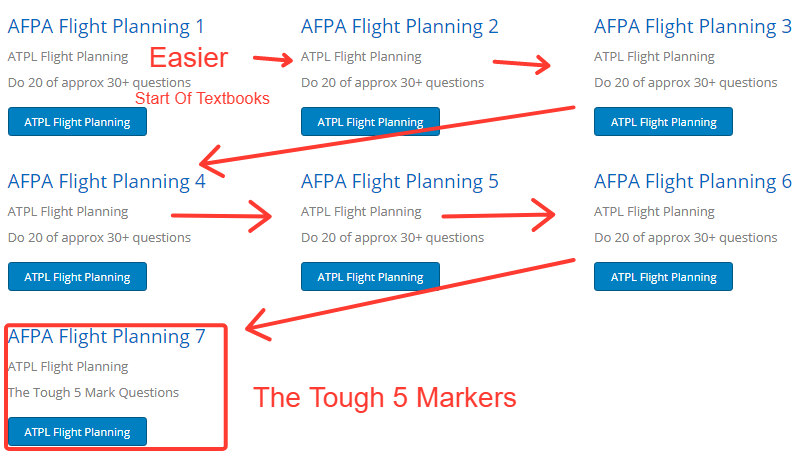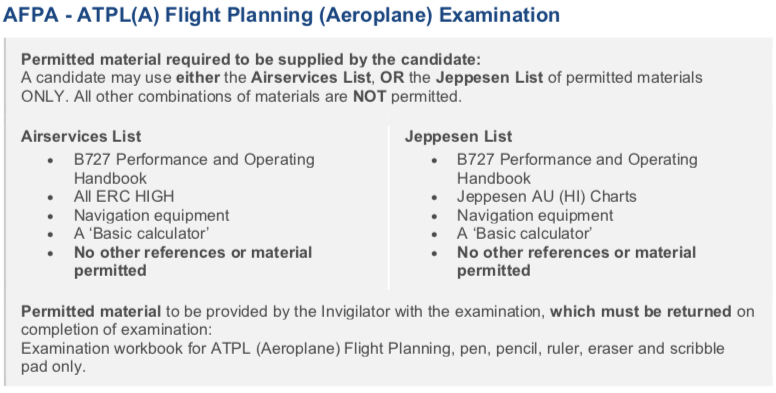ATPL Flight Planning
Important: Membership Needed!
To use the practice exams below you need the AFPA or ATPL All 7 Practice Exams Membership!
Use the button to purchase, or if you already have one of these memberships click here to login.
ATPL Flight Planning (AFPA)
AASA 3 hour exam, 70% pass mark.
These exams build knowledge and get progressively harder. The five mark questions are in AFPA Flight Planning 7.
The fuel requirements shall be carried in accordance with those specified in the Boeing 727 Performance & Operating Handbook..ie no change.
New ATPL APLA Workbook V 1.1 – 02 Dec 2021 replaces the ATPL Aeroplane weight and balance syllabus. Weights for workbook and B727 Handbook now align. Load and trim sheet now only has minor changes to weight 63502 v 63500. For all intentions the trim sheets remain the same. It will also include TO and LDG charts from B727 Handbook pages 2-5, 2-6, 4-5 and 4-9.
CAO 20.7.1B replaced by CASR 121 and Part 121 MOS
New obstacle clearance and drift down requirements, V speeds climb gradients.
Standard weight for passengers other than Blue Sky Airlines operations.
Introduced new fictitious Blue Sky Airlines who has approval to use existing passenger weights
Flight planning is too tough a subject to not build progression into the practice exams. The first exams are relatively easy and for building and testing fundamental knowledge. As the exams progress , they will get harder. The last exam includes the 5 mark questions that can take 15 to 20 minutes to answer.

Usually a CASA question will tell you if it is a step climb or not. If it is a normal ops PNR question when asked to fly at the highest level possible, you will likely have to do a step climb on the return leg.
AFPA Flight Planning 1
ATPL Flight Planning
Do 20 of approx 30 questions
AFPA Flight Planning 2
ATPL Flight Planning
Do 20 of approx 30+ questions
AFPA Flight Planning 3
ATPL Flight Planning
Do 20 of approx 35 questions
AFPA Flight Planning 4
ATPL Flight Planning
Do 20 of approx 30+ questions
AFPA Flight Planning 5
ATPL Flight Planning
Do 20 of approx 25+ questions
AFPA Flight Planning 6
ATPL Flight Planning
Do 14 questions
AFPA Flight Planning 7
ATPL Flight Planning. Do 10 of 35+ questions.
The Tough 4 & 5 Mark Questions
AFPA Flight Planning 8
ATPL Flight Planning. Do 20 of 60+ questions.
Tougher 2 & 3 Mark Questions
AFPA Flight Planning 9
ATPL Flight Planning. Do 10 of 25+ questions.
A Variety Of New Questions
The vast majority of the syllabus areas have been satisfactorily handled. The following represents a few of the important areas where candidates may require better preparations. They are:
- Ground speed (by far the most frequent error) and fuel policy errors (a close second) were common in most exams where the candidates work was reviewed
- Determine highest cruise level for abnormal operations
- Determine maximum payload at planning
- Determine landing weight for abnormal operations
- Determine the position of a PNR, whether Normal Operations (PNR/NO) or Abnormal operations (PNR/DP, PNR/1 IN-OP)
- Normal operations flight plan – either as a forward or backward plan appeared to create great difficulties
Port Hedland to Christmas Island
Distance: 1,095.50 mi (1,763.03 km)
Familiarise yourself with ERC-H 4 – Route 206 ~956 NM

About ATPL flight planning, what makes it very difficult is that it requires precision in a small window of time , the last 4 questions make up 46% of the total marks, stuff more than one up and you can almost sing la la bye, the knowledge of procedures very thoroughly is a must, you cannot afford to not be sure of what to do.
Canberra to Hobart
Familiarise yourself with ERC-H 3 – Route J136 ~458 NM
Note the distance between Hobart and KAREN is not visible on ERC-H
The big questions were on route planning Port Headland – Christmas Island and Canberra – Tasmania.
Know the definitions like block time etc, so you don’t waste time wondering in the exam.
They make up 45%+ of the exam.
Acceptable “tolerances” seem to be to the nearest 1 nm, 1 kg, etc. Be sure you use the “rounding” rules in the CASA ATPL exam information booklet.
Do not interpolate except as specified.
They seem to want you to follow the SOPs.
Follow the rules for selecting wind level, temp deviation and apply correct alternate requirements, you should get the correct answer.
Refer to CAAP 215-1(3): Guide to the preparation of Operations Manuals 25 Effective from 08 November 2018
You will find this very handy for seeing what CASA considers important in flight planning.
Starts about page 25 on the PDF, Be sure to read the Explanation Of Headings, which has references.
PART B – STANDARD OPERATING PROCEDURES
2B1 Flight Planning and Preparation
2B1.1 Planning and briefing materials:
• Operational flight plan requirements
• Flight plan terminology and format decoder
• Authorised weather forecasts/reports
• Flight category
• Airspace classification and tracking restrictions
2B1.2 Planning systems
2B1.3 Notice to Airmen (NOTAM)
2B1.4 Route and aerodrome briefing
2B1.5 Planning altitudes and flight levels
2B1.6 Restricted and prohibited areas
2B1.7 Minimum Safe Altitudes/Lowest Safe Altitude (LSALT)
2B1.8 Aircraft Performance Limitations:
• Holding and Instrument Approach and Landing (IAL)
• Maximum angle of bank
• Maximum rate of descent
2B1.9 Point of No Return/Alternate (PNR/A) and Critical/Equi-Time Point Calculations
2B1.10 Extended Diversion Time Operations (EDTO)
2B1.11 ASEA operations
2B1.12 Suitable aerodromes/Helicopter Landing Sites (HLS)
2B1.13 Rescue and Fire Fighting (RFF) requirements
2B1.14 Alternate aerodromes/HLS
2B1.15 Airspace classification requirements
2B1.16 Flights over water
2B1.17 Bird/animal avoidance procedures
Then on Page 28 and 29
2B2 Fuel Policy
2B2.1 Minimum Planning Requirements
2B2.2 Trip fuel
2B2.3 Alternate Fuel
2B2.4 Variable Fuel Reserve
2B2.5 Fixed Fuel Reserve
2B2.6 Holding Fuel
2B2.7 Additional Fuel
2B2.8 In-flight re-planning*
2B2.9 Fuel load weight and balance
2B2.10 Quantity measurement
2B2.11 Fuel type and quality checks
2B2.12 Fuel quantity cross-checks pre and in-flight
2B2.13 Fuel usage records
2B2.14 Fuelling Operations:
• Hot refuelling
• Refuelling with passengers on board
• Defuelling
• Drum stock
• Fuelling at overseas ports.
2B2.15 Location of aircraft during refuelling
2B2.16 Post-fuelling quantity cross-check
2B2.17 Water contamination
2B2.18 Fuel anti-freeze procedures
2B2.19 Ignition hazard management
2B2.20 Fuel spillage
2B2.21 Fuel jettison
2B2.22 Conditions for flight to remote islands
2B2.23 EDTO
2B2.24 Engine oil management
Page 29 has all the references.
General information and advice on implementing a fuel policy is published in CAAP 234-1, but future CASR Operational Parts will have specific requirements for fuel management in Regulations and Manual of Standards. Further specific topic and general references are also set-out below:
• Alternate Fuel – AIP-ENR Alternate Aerodromes
• Holding Fuel – AIP-ENR Fuel Requirements
• Fuel quantity cross-checks CAO 20.2.6, CASR 137.150 (AAp)
• Fuel usage records – CAR 220 (also see Record Keeping (1A4)
• Fuelling Operations – CASR 137.115, CAO 20.9.4, 20.10.1 (AWK), 20.10.7.2
(b) (Heli)
• Fuel Jettison – AIP-ENR Fuel Dumping in Flight
• Conditions for flight to remote islands – CAO 82.0.3A
• EDTO – CAO 82.0 Appendix 5.6
The following references are generally applicable to an operator’s fuel policy and aircraft fuelling requirements (also see examples at Annex B to this CAAP):
• CAR 138, 220, 233, 234, 239, 240 and CAR 244
• CAO 20.2, 20.9.3, 20.10, 20.10.1, 20.16.1, 82.0
• CAO 82.1 Appendix 1
• CAO 82.3 Appendix 1
• CAO 82.5 Appendix 1
• Aircraft Flight Manuals
• Pilots Operating Handbooks
15 questions and usually takes the whole time to complete them do the big marks first.

What Is Examined?
1 INTRODUCTION
1.1 The Flight Planning examination tests Unit 1.10.2 of Schedule 3 of the MOS, but may include items from earlier Units, including the following items:
• Practical application – climb, cruise and descent.
• Practical Flight Planning and Flight Monitoring.
1.2 Questions are, in the main, ‘practical’ types based on the Boeing 727 aeroplane, and in general will require the use of the Boeing 727 Performance and Operating Handbook (Abbreviated)*. Questions may be based on any section of the Handbook.
* hereafter referred to as the Handbook.
Required Reading:
THE AUSTRALIAN AIR TRANSPORT PILOT LICENCE (AEROPLANE) EXAMINATION INFORMATION BOOK
If you fail to read this booklet for this subject you will undoubtedly fail the exam.
Recommended Reading:
THE AUSTRALIAN AIR TRANSPORT PILOT LICENCE (AEROPLANE) EXAMINATION INFORMATION BOOK
Boeing 727 Performance & Operating Handbook*
Aeroplane Performance, Planning & Loading for the Air Transport Pilot by Aviation Theory Centre
